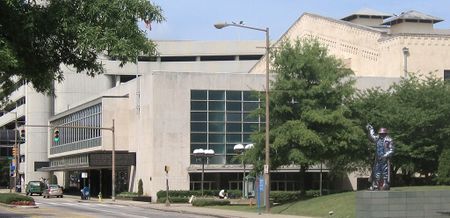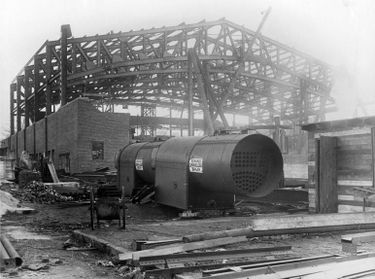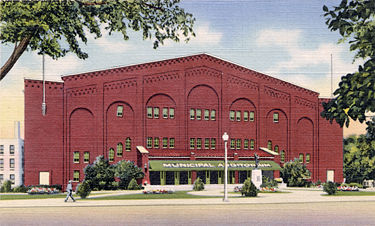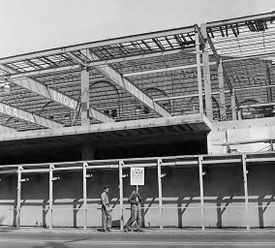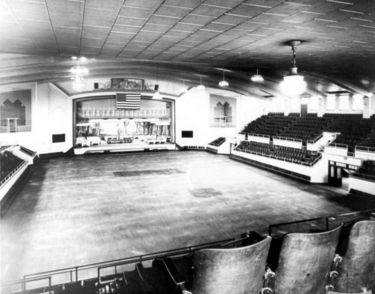Boutwell Auditorium
- This article is about the current municipal auditorium. For the 1890s civic auditorium, see Birmingham Auditorium.
Boutwell Auditorium (also known as Boutwell Memorial Auditorium, Historical Boutwell Municipal Auditorium, and formerly Municipal Auditorium) is a city-owned 5,000-seat multi-purpose arena located at 1930 8th Avenue North, facing Linn Park. The total capacity of the hall, utilizing floor seating, is 6,000.
The auditorium is home to the Birmingham Power basketball team. Kevin Arrington is the facility's director.
History
The need for a public auditorium had been recognized for decades. The Birmingham Auditorium on the northwest corner of 17th Street and 3rd Avenue North had been completed in 1896, but was sold two years later to Vaudeville promoter Jake Wells and had closed, albeit temporarily, in 1915.
In 1916 architect Eugene Knight prepared a proposal for completing the unfinished Roden Hotel as a new city auditorium with space for city hall functions, including the Birmingham Public Library and Birmingham City Jail on the upper floors. The Birmingham Chamber of Commerce endorsed the proposal, but it was not carried out and the hotel's bare structure was sold for scrap in 1917.
A campaign to inspire community support for a bond issue to fund a municipal auditorium was initiated by the Birmingham Chamber of Commerce in 1919. Morris Bush chaired the auditorium committee which recruited campaign workers from area businesses. The chamber funded the campaign at a cost of $1,500. On the day of the referendum, business owners were encouraged to send their workers to the polls. The issue passed by a 3 to 1 margin. A separate advisory committee, chaired by Chamber president Robert Brown worked with the Birmingham City Commission to select a site and develop plans for the building.
Proposals ranged from 3,500 to 10,000 seats. The design of the auditorium was given over to a committee dubbed the "Associated Architects of Birmingham". Nationally-known theater designer Thomas W. Lamb was engaged as a consultant. A second bond referendum was passed, providing $500,000 for construction of the auditorium and for new schools and renovations to schools, libraries, parks and playgrounds. In the 1922 Birmingham municipal election a new slate of city commissioners was elected on the "larger is better" ticket and the 10,000-seat option was pursued. Harry Breeding's design, which included a corner stage and a 70-foot diameter domed roof, was initially favored by city leaders from a number of designs submitted by September 1, but was later rejected as impractical. The architects' committee resumed work under the leadership of Harry Wheelock and eventually settled on a flexible arrangement which could accommodate 6,000 for staged events or could be opened up for exhibitions.
The style of the facade, possibly influenced by David O. Whilldin and Bem Price, was simplified into a brick "Lombard" or Northern Italian style with shallow blind arches and a raked cornice projecting slightly on corbels spanned by small arches. The less expensive design differed from the idea championed by Frank Anderson, William Warren and Eugene Knight for a unified Municipal Plaza surrounded by monumentally-scaled limestone-clad Classical buildings.
The auditorium itself was set back from the street to allow for the future addition of an entry pavilion, the design of which might better compliment the hoped-for assemblage of Classical structures. Day & Sachs were given the construction contract. The face bricks were "Red Range Orientals" furnished by the Stephenson Brick Co.
The completed auditorium was dedicated on June 1, 1924. A statue entitled "Spirit of the American Doughboy", donated to the American Legion, Birmingham Post No. 1 by the city's Greek-American citizens, was dedicated at the front entrance in November 1923. In the 1930s a project to "complete" the Birmingham Municipal Auditorium was undertaken under the auspices of the federal Works Progress Administration (WPA).
A 1957 renovation, executed by Charles McCauley, added to the lobby and meeting room space in front of the brick facade, giving the street view of the auditorium a decidedly modernist marble, aluminum and glass look. Ingalls Iron Co. erected the steel frame for the addition. Construction of the new entrance was interrupted by a labor strike. The exhibition area has a maximum capacity of 1,000.
The building was later renamed for former mayor Albert Boutwell.
Notable events
In the Spring of 1925 the Ku Klux Klan sponsored a minstrel show at the auditorium to raise funds for Birmingham City Schools. The system had shut down in April for lack of funds. The show brought in over $3,400 which was paid out to teachers who had volunteered to complete the school year without pay.
Aviator Charles Lindbergh was toasted at Municipal Auditorium during his 1927 visit to Birmingham.
The auditorium was the site of the November 1938 Southern Conference for Human Welfare during which more than 1,200 delegates, both black and white, met to discuss issues of human welfare on the way toward overcoming the effects of the Great Depression. The proceedings were interrupted when Birmingham City Commissioner Bull Connor ordered participants not to "segregate together". His order was defied by First Lady Eleanor Roosevelt, who pulled her chair into the center aisle. Later she and other panelists addressed an integrated crowd of 5,000, with another 2,000 outside the doors. Notable guests included Mary McLeod Bethune, Hugo Black, Donald Comer, Bibb Graves, Charles S. Johnson, and Claude Pepper.
Don Bestor and the NBC Orchestra played for a week of dances at the Municipal Auditorium in December 1939. On August 1, 1942 and July 11, 1943 the "Sergeant Gene Autry" radio variety program was aired live from Municipal Auditorium on the CBS Radio Network. As planned by the Kiwanis Club of Birmingham, which promoted the show in 1943, attendees were required to purchase war bonds payable to the Crippled Children's Clinic. The event was also notable because African-American servicemen performed with Autry and the CBS Orchestra. In December of that year "The Battle of Music", benefitting the Negro Tuberculosis Association, pitted the Fess Whatley Orchestra against Bob Harris' Orchestra and Sonny Blount's Band.
On November 26, 1946 the auditorium was the setting of a Jubilee Banquet for 2,500 people celebrating the city's 75th anniversary. Executives from U.S. Steel and a staffer from the office of the Lord Mayor of Birmingham, England attended as special guests of the Birmingham Chamber of Commerce.
The auditorium also hosted the 1948 States Rights Democratic Party convention at which Strom Thurmond was nominated to run for president against incumbent Democratic nominee Harry S. Truman and Republican candidate Thomas E. Dewey. The States Rights Democrats, better known as "Dixiecrats" were formed when a number of Southern delegates to the Democratic National Convention in Philadelphia walked out after Minneapolis Mayor Hubert Humphrey called for the party to "get out of the shadow of states' rights and walk forthrightly into the bright sunshine of human rights."[1] That December Count Basie and his orchestra played on the auditorium stage.
In 1951 Pizitz held a "Dramatic Disposal Sale" of surplus merchandise at the auditorium, with buses running to the site from the company's main store.
On April 10, 1956 singer Nat King Cole was attacked by three white assailants during a segregated performance. He had been welcomed to the stage by Mayor Jimmy Morgan to joyful cheers from the youthful white audience and was into his third song when members of Asa Carter's Ku Klux Klan of the Confederacy, rushed the stage. Cole returned to the stage to thank the audience for their support, but did not complete the performance. During May of the same year two monumental rock and roll concerts featuring Fats Domino, Little Richard, the Cadillacs, Bill Haley and the Comets, the Platters, Bo Diddley, the Drifters drew (segregated) crowds and picketers to the auditorium. On July 10, 1960 a rock'n'roll show at the auditorium was stopped by police after a shooting in the restroom.
In May 1966 International Tape Cartridge Corporation president Larry Finley presented Herb Alpert with the inaugural "Golden Cartidge" at Municipal Auditorium, recognizing the Tijuana Brass album "Whipped Cream and Other Delights" as the first "continuous loop stereo tape cartridge" (8-track) to surpass $250,000 in sales. The band played two sold-out shows that evening.
On April 8, 1970 the rock band Chicago performed a concert at the auditorium which was organized by the UAB College of General Studies Entertainment Committee.
In the 1970s promoters Tony Ruffino and Larry Vaughn brought a string of national touring acts to Boutwell. On January 28, 1975 Buckingham Nicks headlined a sold-out show at the auditorium, shortly after Lindsey Buckingham and Stevie Nicks joined Fleetwood Mac. Their success in Birmingham allowed the otherwise unsuccessful duo to go out "in style". Other notable shows included Little Feat on May 29 1978, Black Sabbath with Van Halen as the opening act on November 8 of the same year, the Grateful Dead on December 15, 1978, and Rush on January 29, 1980.
In 1996 the first sections of a the Birmingham Urban Mural were erected on a steel framework on the exterior east wall of the auditorium.
In 1997 Boutwell hosted a watershed event for Birmingham's gay community. After ABC 33/40 declined to air the episode of the television sitcom Ellen which portrayed the title character "coming out" as a lesbian, Birmingham Pride Alabama, with help from the Gay and Lesbian Alliance Against Defamation, organized a screening of the episode at Boutwell. Approximately 2,500 people attended the event and listened to a series of speakers proclaim that gays in Birmingham would no longer be invisible.
On April 25, 2008 Mayor Larry Langford culminated his Plan 10/30 series of anti-violence prayer rallies with an "It's Time to Pray Day". He called on "all Bishops, Priests, Pastors, Ministers and all of our citizens of various denominations and creeds" to join him in donning burlap sacks and having their heads smeared with ashes during the event at Boutwell Auditorium.
On February 16, 2019 the auditorium hosted "A Conversation with Dr Angela Davis", hastily organized as an alternative to the Birmingham Civil Rights Institute's "Fred L. Shuttlesworth Human Rights Award" banquet which had been scheduled for the same night. Davis had been announced as the recipient of that award, but the BCRI's board rescinded the honor, leading a newly-formed Birmingham Committee for Truth and Reconciliation to put together an alternative. Originally planned for the Lyric Theatre, the event was moved to Boutwell to accommodate high demand for tickets.
In July 2022 Boutwell hosted the kickboxing, muaythai, and sumo competitions of the 2022 World Games.
See also
Other events
In its heyday the Municipal Auditorium hosted major concerts and touring shows such as Ringling Bros. and Barnum & Bailey Circus and the Holiday on Ice tour.
Boutwell has routinely hosted the Festival of Arts, the Festival of Sacred Music, the Martin Luther King Day Prayer Breakfast and other public events. It was also the location for most of WVOK-AM's memorable Shower of Stars concerts and for frequent boxing, wrestling and ultimate fighting events. Notable concert bookings at Boutwell include Gene Autry, Bruce Springsteen, Parliament and Nirvana.
Each December, beginning in 1944, the auditorium hosted a free Civic Christmas Carol Service, or All-City Christmas Music Festival, with numerous church choirs and civic choruses participating.
Since 1999, at the suggestion of Don Lupo, the city has periodically opened the facility for use as a warming station for homeless individuals during sub-freezing weather. Donated clothing and blankets are distributed and meals are served by Heart to Table and other groups. The auditorium is also used for Project Homeless Connect, an all-day multi-agency event aimed at providing critical services to the homeless.
On January 18, 2016 a planned Southern Christian Leadership Conference Martin Luther King Day luncheon and a political rally for Democratic presidential candidate Bernard Sanders caused the facility not to open to the homeless during a sub-freezing night. Lupo hoped the tempest of criticism would result in efforts to expand emergency services to the homeless independent of the city auditorium.
Status
Master plans for the future of the Birmingham Museum of Art, which adjoins Boutwell Auditorium, have included expanding onto its current site. The possibility was made part of the Regional Cultural Arts Master Plan in 2002.
In December 2007, Mayor Larry Langford asked the Birmingham City Council to demolish the building, which he claimed had an annual operating deficit of more than $1 million. He recommended that the site be donated to the Museum for future expansion. According to Langford the city spends $1.2 million each year operating and maintaining the structure and only takes in $200,000 in revenues.
The City Council has delayed voting on Langford's proposal until more information can be gathered, including recent and scheduled bookings and fees and cost estimates for demolition.
In late September 2008, the city architect released a report stating that repairing safety hazards, providing access for the disabled and correcting building code violations at Boutwell would cost the city more than $4 million to repair.
Meanwhile, Boutwell is one of the sites identified as important to the understanding of Birmingham's role in the Civil Rights Movement and is listed among properties included in a proposal for Alabama's Civil Rights Churches to be added to UNESCO's roster of World Heritage Sites.
References
- "Birmingham's Proposed New City Hall-Auditorium" (April 29, 1916) Birmingham Age-Herald
- "Vigorous Campaign Lands Auditorium for Birmingham" (September 1919) Birmingham magazine - accessed via Birmingham Public Library Digital Collections
- White, Marjorie Longenecker (1977) Downtown Birmingham: Architectural and Historical Walking Tour Guide. Birmingham: Birmingham Historical Society
- Bryant, Joseph D. (February 19, 2006) "Boutwell has history, but not considered historic." The Birmingham News
- Boulard, Garry. (June 24, 1997) You can go home again." The Advocate
- Wolfson, Hannah (December 19, 2007) "Birmingham City Council delays vote on Boutwell Auditorium demolition; more information sought." The Birmingham News
- Eskew, Glenn T. (January 13, 2008) "Saving history: Auditorium an important part of nation's past." The Birmingham News
- Whitmire, Kyle (April 25, 2008) "Langford sports sackcloth, ashes, Rolex" Birmingham Weekly
- Baggett, James L. (May 2008) "Rock 'n' Roll is Here to Stay." Birmingham Magazine. Vol. 48, No. 5, p. 246
- Bryant, Joseph D. (September 29, 2008) "Boutwell Auditorium safety, code problems top $4 million." The Birmingham News
- Shelby, Thomas Mark (2009) D. O. Whilldin: Alabama Architect. Birmingham: Birmingham Historical Society ISBN 0943994330
- Eskew, Glenn T. (October 9, 2011) "Boutwell's history should earn venue its preservation." The Birmingham News
External links
- Boutwell Auditorium at birminghamal.gov
- Photograph of the Municipal Auditorium audience for the 1942 "Sgt. Gene Autry" radio program in the Alabama Media Group collection at the Alabama Department of Archives and History
